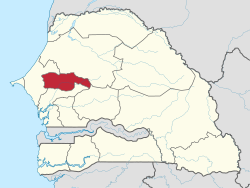Diourbel Region
|
Diourbel Region Région de Diourbel |
|
|---|---|
| Region | |
 Location of Diourbel in Senegal |
|
 Diourbel région, divided into 3 départements |
|
| Coordinates: 14°45′N 16°15′W / 14.750°N 16.250°WCoordinates: 14°45′N 16°15′W / 14.750°N 16.250°W | |
| Country | Senegal |
| Capital | Diourbel |
| Départements | |
| Area | |
| • Total | 4,824 km2 (1,863 sq mi) |
| Population (2013 census) | |
| • Total | 1,420,082 |
| • Density | 290/km2 (760/sq mi) |
| Time zone | GMT (UTC+0) |
The Diourbel Region (Serer and Cangin: Jurbel) is a region of Senegal. The regional capital is the city of Diourbel. The region corresponds roughly to the precolonial Kingdom of Bawol and is still called by that name. Bawol (or Baol) is an ancient kingdom formerly ruled by the Joof family, one of the members of the Serer ethnic group found in Senegambia. Inhabitants of the area are called Bawol-Bawol which takes its name from the Serer mode of pluralisation, other examples being : Sine-Sine or Siin-Siin (inhabitants of Sine), Saloum-Saloum (inhabitants of Saloum), etc. The population is overrun by the Serer people especially those from the Cangin group, the Safene in particular. The Serers are believed to be the original inhabitants of this area. The Wolof and other ethnic groups are also present. The Diourbel Region is rich in history and it is where the Cekeen Tumulus are located. Some scholars such as Charles Becker, Henry Gravrand, Victor Martin among others, suggests that, these monuments were built by the Serer people and form part of the Serer tumulus of Baol (see also Senegambian stone circles). They are some of the most sacred sites in Serer religion. The Department of Mbacke also includes Murid Islamic Sufi order's holy city of Touba. The installation of this order in Serer country is a controversial one, especially among those Serers who adhere to the tenets of Serer religion (see Serer history (medieval era to present). However, some Serers are also Muslims and have headed this religious order.
...
Wikipedia
